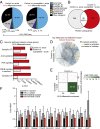Aberrant H3.3 dynamics in NAc promote vulnerability to depressive-like behavior
- PMID: 27791098
- PMCID: PMC5098673
- DOI: 10.1073/pnas.1608270113
Aberrant H3.3 dynamics in NAc promote vulnerability to depressive-like behavior
Abstract
Human major depressive disorder (MDD), along with related mood disorders, is among the world's greatest public health concerns; however, its pathophysiology remains poorly understood. Persistent changes in gene expression are known to promote physiological aberrations implicated in MDD. More recently, histone mechanisms affecting cell type- and regional-specific chromatin structures have also been shown to contribute to transcriptional programs related to depressive behaviors, as well as responses to antidepressants. Although much emphasis has been placed in recent years on roles for histone posttranslational modifications and chromatin-remodeling events in the etiology of MDD, it has become increasingly clear that replication-independent histone variants (e.g., H3.3), which differ in primary amino acid sequence from their canonical counterparts, similarly play critical roles in the regulation of activity-dependent neuronal transcription, synaptic connectivity, and behavioral plasticity. Here, we demonstrate a role for increased H3.3 dynamics in the nucleus accumbens (NAc)-a key limbic brain reward region-in the regulation of aberrant social stress-mediated gene expression and the precipitation of depressive-like behaviors in mice. We find that molecular blockade of these dynamics promotes resilience to chronic social stress and results in a partial renormalization of stress-associated transcriptional patterns in the NAc. In sum, our findings establish H3.3 dynamics as a critical, and previously undocumented, regulator of mood and suggest that future therapies aimed at modulating striatal histone dynamics may potentiate beneficial behavioral adaptations to negative emotional stimuli.
Keywords: H3.3; chronic social defeat stress; depression; histone dynamics; nucleus accumbens.
Conflict of interest statement
The authors declare no conflict of interest.
Figures



References
-
- Kessler RC, et al. National Comorbidity Survey Replication The epidemiology of major depressive disorder: Results from the National Comorbidity Survey Replication (NCS-R) JAMA. 2003;289(23):3095–3105. - PubMed
-
- Nestler EJ, Carlezon WA., Jr The mesolimbic dopamine reward circuit in depression. Biol Psychiatry. 2006;59(12):1151–1159. - PubMed
-
- Charney DS, Manji HK. Life stress, genes, and depression: Multiple pathways lead to increased risk and new opportunities for intervention. Sci STKE. 2004;2004(225):re5. - PubMed
Publication types
MeSH terms
Substances
Grants and funding
LinkOut - more resources
Full Text Sources
Other Literature Sources
Medical
Molecular Biology Databases

